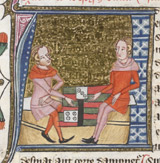 |
 |
 |
 |
 |
 |
 |
|
The Opusculum ('Omne Bonum') of Jacobus Anglicus: a fourteenth-century English Cistercian (1/3) This vast and wide-ranging work is in many ways unique, for it is the only scientific compilation by an English Cistercian at this time.(45) This is a volume of general information, based on over a hundred authorities, but everything is informed by canon law. Indeed, the author even debates whether or not it is lawful for a monk to suck a lozenge when celebrating the Divine Office, if this is intended to improve his performance.(46) The work, which may have been compiled c.1326/1347 or later in the century, is unfinished.(46a) It includes material relating to philosophy, medicine, history and astronomy. The work proper is preceded by a number of illustrations. These are of the Old Testament and the Life of Christ, the Instruments of the Passion, the Vision of St Benedict and the Beatific Vision of Pope Benedict XII in 1361. Hundreds of illuminated miniature initials are incorporated within the main body of the work, to illustrate the text. These include images of monastic life and also of life outside the monastery. including a royal banquet, the treatment of brain disease and of astrologers at work. The Opusculum is not simply of interest for its wide-range of subject-matter and emphasis on canon law, but also for the author’s blatant hostility to the friars. In this respect, it has been argued that James reflects the opinion and attitude of his fellow Cistercians at Oxford at this time.(47) Indeed, a poem of c. 1360, written by a friar at Oxford, names the ruddy-faced abbot of Louth Park as one of three monks who voiced their dislike of the mendicants. [View images from the Omne Bonum] |
||
|
